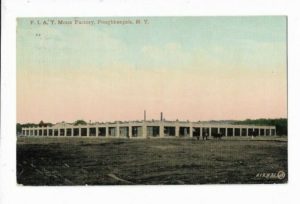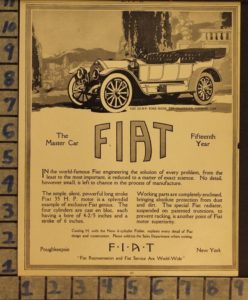 In 1909, a Fiat auto plant was established in Northern Poughkeepsie, NY, a testament to the pioneering spirit of a wealthy diamond merchant. His vision was to sell cars to affluent Americans, a concept ahead of its time. The factory, located across from Marist College and bordered by Rt9 and Fulton Street, focused on producing large cars to compete with other luxury car brands of the time, such as Peerless and Pierce-Arrow. The prices of the vehicles ranged from $4000 to $6100, which would be about $101,900 to $155,340 in today’s money when adjusted for inflation.
In 1909, a Fiat auto plant was established in Northern Poughkeepsie, NY, a testament to the pioneering spirit of a wealthy diamond merchant. His vision was to sell cars to affluent Americans, a concept ahead of its time. The factory, located across from Marist College and bordered by Rt9 and Fulton Street, focused on producing large cars to compete with other luxury car brands of the time, such as Peerless and Pierce-Arrow. The prices of the vehicles ranged from $4000 to $6100, which would be about $101,900 to $155,340 in today’s money when adjusted for inflation.
Advertisement
Despite common belief, this venture was a private initiative and did not need to be financially supported by Fiat of Italy. The American company paid a royalty to Fiat in Turin, Italy, for each chassis while having rights to all of the Italian designer’s patents.
While Fiat in Turin, Italy, produced both small, fast cars and larger touring cars, the American company focused more on large touring cars and the mammoth Type 56, 45 HP, 6-cylinder, 7-passenger Limousine model with four-speed manual transmission. This car, a true engineering marvel, weighed about 5,000 pounds, had no front brakes, and cost about $5,000. Surprisingly, 45hp could move a 5,000-pound car!
In 1912, the plant produced over 300 vehicles annually. Production peaked in 1914 with four different models, but by 1918, the venture had essentially ended.
In 1917, Fiat in Italy took over the American Poughkeepsie Fiat Plant, and the Type 55 became the only offering until production ceased by the end of the year, owing to the devastating impact of World War I. The plant was manufacturing munitions for the war effort at that time. Many attribute the venture’s demise to WWI and the lack of a competitively priced vehicle. In 1935, Western Publishing took over the site until 1983, after which it was used by Marist College, Staples, a Job Lot, and a Home Depot.
Advertisement
Share this!
072624


